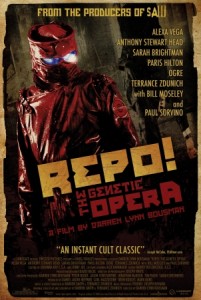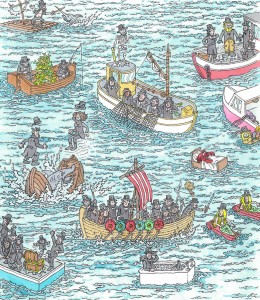 Andy Gracie, “The Quest for Drosophila titanus,” 2011 Science at Play: Bioart in Brooklyn
March 23–May 11, 2013
Opening reception: Saturday, March 23, 8 PM
Gallery hours: Saturdays & Sundays 12–6 PM
Life is restless. Bioartists—the emerging group of practitioners who manipulate living tissues, DNA, and bacteria—must embrace this restlessness. Working in the lab, the artist can’t contain his medium. Even in the Petri dish, fungal spores invade the colonies, or the slime mold overruns maze. Precision gives way to open-ended experiment. The lab is a garden, and the bioartist is the gardener for the new millennium, where breeding advances naturally into gene splicing.
CUT/PASTE/GROW provides a space to ask fundamental new questions about aesthetics and our assumptions about life and death. What, for example, makes a beautiful blueprint for a beautiful form—what makes a beautiful gene?
By cutting and pasting DNA into a being, the organism itself—both in function and behavior—becomes a chimera, a hybrid natural/engineered being stitched from disparate parts, a result of both Darwinian evolution and the will of the artist.
Since antiquity, hybrids were considered abominations. Today, we can view them in any number of ways: Are these chimerae quasi-artworks or quasi-organisms? Is bioart a new approach to society and ecology, a partnership with the microbial life all around us?
Find out more at cutpastegrow.com
Invited artists:
- Tuur van Balen
- Nurit Bar-Shai
- Heather Barnett
- BCL: Shiho Fukuhara/Georg TremmelBruce Bryan
- Revital Cohen
- Tom Deerinck
- Andy Gracie
- Karen Ingram
- Eduardo Kac
- Edgar Lissel
- Julia Lohmann
- Simon Park
- Nikki Romanello
- SXSW Create 2013
- Liam Young
Curators
Observatory is an gallery and event space in the Gowanus neighborhood of Brooklyn, New York. Inspired by natural history, morbid anatomy, and the intersection of art and science, Observatory hosts lectures, classes, and exhibitions. Observatory is part of the Proteus Gowanus art complex, located at 543 Union Street (at Nevins). Gallery hours are 3–6 PM, Thursdays–Fridays; 12–6 PM, Saturdays–Sundays.
Genspace is a nonprofit organization dedicated to promoting education in molecular biology for both children and adults. Its staff and volunteers work inside and outside of traditional settings, providing a safe, supportive environment for training and mentoring in biotechnology. Genspace also supplies a Biosafety Level 1 lab for biologists, laypeople, and artists to gather and collaborate on biotechnology projects.
Nurit Bar-Shai is a co-founder of Genspace and an interdisciplinary artist who works at the intersection of art, science, and technology. She composes video, live telematic installations and conducts experiments through creative collaborative inquiry. Nurit lectures and exhibits her work worldwide.
Daniel Grushkin is a co-founder of Genspace and a journalist who covers the intersection of science, biotechnology, and culture. His articles have appeared in The New York Times, Businessweek, National Geographic Adventure, Popular Science, and Scientific American.
Wythe Marschall writes and teaches about futurism. With artist Ethan Gould, he is the author of Suspicious Anatomy, an illustrated book of fake neuroscience. At Observatory, Wythe has curated art shows and lectures on retrofuturism, technological ecstasy, the neo-grotesque, and the para-academic. Wythe teaches undergraduate literature at Brooklyn College. His stories and essays have appeared in McSweeney’s Quarterly Concern and elsewhere.
William Myers teaches and writes about the history of architecture, art and design. His book BioDesign: Nature + Science + Creativity was published by The Museum of Modern Art in New York and Thames & Hudson in London in 2012. He has worked for the Solomon R. Guggenheim Museum, The Museum of Modern Art, the Smithsonian Cooper-Hewitt National Design Museum, Hunter College, and Genspace.
 CANCELLED DUE TO HURRICANE SANDY CANCELLED DUE TO HURRICANE SANDY
A screening and discussion on dystopian biofictions with writers Dan Grushkin and Wythe Marschall
Date/time: Sunday, November 18, 8 PM
Suggested donation: $7
Specialty drink: DNA cocktails (pineapple juice, strawberries, vodka)
Presented by the Hollow Earth Society and Genspace
Gattaca it ain’t… Paris Hilton co-stars in this near-future, unblinkingly musical, arch-campy gorefest about GeneCo, an evil corporation that creates synthetic organs and repossesses them when clients can’t pay, inevitably killing the clients.
As real biotechnology grows increasingly sophisticated and offers advancements such as the the growth of synthetic tissues and organs, what do lowest-common-denominator fictions such as Repo! tell us about our culture’s hopes and anxieties?
Join biology-obsessed writers Dan Grushkin and Wythe Marschall for a screening of our biotech era’s first “cult classic,” followed by a short discussion.
This screening is the culmination of the second series of classes at Genspace on Genetically Modified Storytelling.
===
Daniel Grushkin writes about the intersection of science, business and culture for a number of science and business magazines, including Scientific American, Discover, Popular Science, Businessweek. He’s a co-founder of Genspace.
Wythe Marschall is the co-author of Suspicious Anatomy, an illustrated book of fake neuroscience, and the co-founder of the Hollow Earth Society. He is a member of Observatory, an art-and-science gallery in Brooklyn. His stories and essays have appeared in McSweeney’s Quarterly Concern and elsewhere.
Check out Dan and Wythe’s recent critique of Ridley Scott’s Prometheus for Scientific American.
 WHERE’S AHAB? WHERE’S AHAB?
Or, embracing the tunnel-visioned, grudge-holding, Mr. Grumpypants blasphemer in us all
(A three-part study of transcendental fury)
With Ted Enik, Daniel Grushkin, & Wythe Marschall
Date: Thursday, August 18
Time: 8:00 PM
Admission: $5
Presented by The Hollow Earth Society
Captain Ahab—the best, first, and darkest dude with a zigzag lightning-bolt scar on his face. Moby-Dick—the unknowable Leviathan.
But wait—don’t forget: Old King Ahab and the God of the Israelites. Quixote and his enchanted armies of giants. The Old Man and the Sea. The Coyote and the Roadrunner. Quint and the Great White. Ripley and the alien broodmother. Kahn and the Enterprise…
Each of us seeks her own Whale. Each of us is susceptible to the obsessive focus of the one-legged captain. We seek an object, perhaps—a talisman that will complete us—or a secret knowledge that will give us power and bring us closer to the Transcendent. We pick at a spiritual scab.
Or perhaps we seek revenge, because to overcome and finally own the object of an obsession plugs a gaping void in our psyche. “That dog has it in for me…” “Old Whiskers is the oldest meanest catfish in the lake. Nobody’ll ever hook him!”
But why do we see in our objects of obsession an intelligence, a clever and evil intentionality that they consummately do not possess? Melville:
All visible objects, man, are but as pasteboard masks… If man will strike, strike through the mask! …I’d strike the sun if it insulted me.
On August 18, we strike through the mask of Ahab himself: Join illustrator Ted Enik and writers Daniel Grushkin and Wythe Marschall as they offer three Ahabs, three perspectives on obsession in literature, and three curious readings of American’s greatest myth. Find out why you know the character having never read the book.
Our strikings (and sea shanties) will entertain and inform both those who have read Moby-Dick and those who have not yet done so. (In fact, there’s a wonderful one-minute-long version of the classic novel on YouTube.)
For who among us has not sought a personal Grail and failed? Who among us can read Ahab’s lyrical musings on the whale and not feel a twinge of shared guilt—a pinprick suspicion that we too have at some point, atop one object of obsession, piled up “all the general rage?”
All that most maddens and torments; all that stirs up the lees of things; all truth with malice in it; all that cracks the sinews and cakes the brain; all the subtle demonisms of life and thought; all evil, to crazy Ahab, were visibly personified, and made practically assailable in Moby-Dick. He piled upon the whale’s white hump the sum of all the general rage and hate felt by his whole race from Adam down; and then, as if his chest had been a mortar, he burst his hot heart’s shell upon it.
***
Kid’s book artist/author, Ted Enik (www.tedenik.com), who isn’t entirely convinced about reincarnation, must have been some sort of sailor-whaler person in a past life. What else would explain his possessing a button concertina, a collection of shantyman’s tunes, and a foul-weather love of Mother Ocean?
Daniel Grushkin is a freelance journalist who covers the cross-section of science, biotechnology and culture. His articles have appeared in The New York Times, Businessweek, National Geographic Adventure, Popular Science, and Scientific American. He is co-founder of Genspace, the world’s first community laboratory focused on biotech education and exploration. The white whale has thus far eluded him.
Wythe Marschall (The Hollow Earth Society, Observatory) is a writer, artist, and lecturer for the English department of Brooklyn College. Wythe’s stories and essays have appeared in McSweeney’s Quarterly Concern and elsewhere. With artist Ethan Gould, Wythe’s first book is Suspicious Anatomy, currently available online (suspiciousanatomy.com) and at fine bookstores in New York City.
|

 CANCELLED DUE TO HURRICANE SANDY
CANCELLED DUE TO HURRICANE SANDY WHERE’S AHAB?
WHERE’S AHAB?